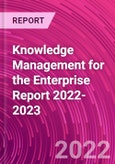The KM Market has Come Alive in 2018, Driven by Growing Interest in Artificial Intelligence
The publisher's second publication on this sector presents an in-depth analysis of the knowledge management (KM) market and the solutions that are vital in supporting the needs of today’s digitally transformed and artificial intelligence (AI)-enabled enterprises.
Knowledge Everywhere for Everyone
Knowledge management solutions help companies institutionalize their knowledge and create a “single source of truth” so that the right information is available to all of their employees and customers. These applications equip employees who work in the contact center or other enterprise functions, as well as self-service solutions, to deliver a frictionless customer experience (CX), throughout the customer journey. The new generation of KM solutions is making information available via enterprise, faceted, or federated search, self-service portals, websites, and user communities. Information can also be pushed automatically to agent desktops or customer relationship management (CRM) applications based on context and intents identified in voice and digital interactions. Knowledge management solutions are also increasingly being used to support enterprise-wide AI initiatives that need a large repository of relevant, tagged, and targeted data to be effective.
Getting the right information (answers, FAQs, best practices, calculations, guides, decision trees, etc.) properly formatted and loaded, and keeping it current, has been a time-consuming manual process for decades. But this is changing due to greatly enhanced AI-enabled KM solutions that apply machine learning (ML) to self-identify knowledge gaps, redundant answers, outdated or poor-performing content, and recommend fixes to solve these issues. Employees are still needed to make final decisions about the content, but ML has already reduced the effort by as much as 50%, and more innovation is on the way.
Timely, Comprehensive and Insightful Analysis
The Knowledge Management for the Enterprise report examines the competitive landscape, technology, products, functional capabilities, and the business, servicing, and market trends that are driving rapid adoption and game-changing innovation of KM applications. The report features 5 highly effective KM solutions that address customer and agent/employee-facing functions and other enterprise-wide uses. The vendors covered are: KMS Lighthouse, NICE, Serviceware, Shelf, and Verint Systems. This Report is intended to help companies identify and select the right KM solution to meet their current and future needs.
Report includes
- Definition of KM and the distinctions between search, content management, and KM
- Market trends and challenges that are driving interest, adoption, and product development in this sector
- Knowledge management vendor innovation and near-term roadmaps, including new product features and what is planned to be delivered in the next 12 - 18 months
- Insightful discussion of how digital transformation and changes in the post-pandemic workplace are reviving interest in KM
- Exploration of how KM solutions are serving up context-based information to deliver an enhanced self-service experience while improving containment rates
- How contact centers are leveraging KM as a retention tool by delivering a better way to coach and support agents, improve their performance, and promote higher levels of job satisfaction
- A look at how KM is helping enterprises capture and preserve the institutional knowledge of their tenured and retiring workforce
- Examination of the asset management workflow in the 5 featured KM solutions, including data acquisition, authoring, review, revision and approval process, publication/distribution, and search capabilities
- Review of the KM competitive landscape, including the technology sectors that are developing KM solutions as well as an overview of the 5 featured KM vendors, their product offerings, and packaged solutions
- Side-by-side comparative analysis of the technical and functional capabilities of the 5 featured KM solutions
- Knowledge management implementation analysis, including vendor methodology, time frames, best practices, professional services, training/workshops, and resources required to implement and maintain the solution
- Knowledge management uses, benefits, and return on investment (ROI) analysis
- Results of the publisher's comprehensive customer satisfaction survey, which ranks vendors based on customer satisfaction across 10 vendor categories, 9 KM product capabilities, 5 customer-facing capabilities, and 5 agent/employee-facing capabilities
- Knowledge management vendor pricing
- Detailed company reports for the 5 KM vendors, analyzing product functionality and near-term product roadmap deliverables
- Glossary of Terms
- Knowledge Management Vendor Director
Table of Contents
1. Executive Summary2. Introduction
Companies Mentioned
- KMS Lighthouse
- NICE
- Serviceware SE
- Shelf
- Verint Systems








